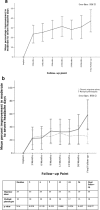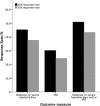Long-term outcomes of occipital nerve stimulation for chronic migraine: a cohort of 53 patients
- PMID: 27475100
- PMCID: PMC4967414
- DOI: 10.1186/s10194-016-0659-0
Long-term outcomes of occipital nerve stimulation for chronic migraine: a cohort of 53 patients
Abstract
Background: Chronic migraine affects up to 2 % of the general population and has a substantial impact on sufferers. Occipital nerve stimulation has been investigated as a potentially effective treatment for refractory chronic migraine. Results from randomised controlled trials and open label studies have been inconclusive with little long-term data available.
Methods: The long-term efficacy, functional outcome and safety of occipital nerve stimulation was evaluated in an uncontrolled, open-label, prospective study of 53 intractable chronic migraine patients.
Results: Fifty-three patients were implanted in a single centre between 2007 and 2013. Patients had a mean age of 47.75 years (range 26-70), had suffered chronic migraine for around 12 years and had failed a mean of 9 (range 4-19) preventative treatments prior to implant. Eighteen patients had other chronic headache phenotypes in addition to chronic migraine. After a median follow-up of 42.00 months (range 6-97) monthly moderate-to-severe headache days (i.e. days on which pain was more than 4 on the verbal rating score and lasted at least 4 h) reduced by 8.51 days (p < 0.001) in the whole cohort, 5.80 days (p < 0.01) in those with chronic migraine alone and 12.16 days (p < 0.001) in those with multiple phenotypes including chronic migraine. Response rate of the whole group (defined as a >30 % reduction in monthly moderate-to-severe headache days) was observed in 45.3 % of the whole cohort, 34.3 % of those with chronic migraine alone and 66.7 % in those with multiple headache types. Mean subjective patient estimate of improvement was 31.7 %. Significant reductions were also seen in outcome measures such as pain intensity (1.34 points, p < 0.001), all monthly headache days (5.66 days, p < 0.001) and pain duration (4.54 h, p < 0.001). Responders showed substantial reductions in headache-related disability, affect scores and quality of life measures. Adverse event rates were favourable with no episodes of lead migration and only one minor infection reported.
Conclusions: Occipital nerve stimulation may be a safe and efficacious treatment for highly intractable chronic migraine patients even after relatively prolonged follow up of a median of over 3 years.
Keywords: Chronic migraine; Headache; Neurostimulation; Occipital nerve stimulation.
Figures


Similar articles
-
Long-term follow up of intractable chronic short lasting unilateral neuralgiform headache disorders treated with occipital nerve stimulation.Cephalalgia. 2018 Apr;38(5):933-942. doi: 10.1177/0333102417721716. Epub 2017 Jul 14. Cephalalgia. 2018. PMID: 28708008
-
Occipital Nerve Stimulation for Refractory Chronic Migraine: Results of a Long-Term Prospective Study.Pain Physician. 2017 Jan-Feb;20(1):E151-E159. Pain Physician. 2017. PMID: 28072807
-
Treatment of intractable chronic cluster headache by occipital nerve stimulation: a cohort of 51 patients.Eur J Neurol. 2017 Feb;24(2):381-390. doi: 10.1111/ene.13215. Epub 2016 Dec 20. Eur J Neurol. 2017. PMID: 27995704
-
Dual occipital and supraorbital nerve stimulation for chronic migraine: a single-center experience, review of literature, and surgical considerations.Neurosurg Focus. 2013 Sep;35(3):E9. doi: 10.3171/2013.6.FOCUS13233. Neurosurg Focus. 2013. PMID: 23991822 Review.
-
Four Decades of Occipital Nerve Stimulation for Headache Disorders: A Systematic Review.Curr Pain Headache Rep. 2024 Oct;28(10):1015-1034. doi: 10.1007/s11916-024-01271-1. Epub 2024 Jun 22. Curr Pain Headache Rep. 2024. PMID: 38907793
Cited by
-
Review of craniofacial pain syndromes involving the greater occipital nerve: relevant anatomy, clinical findings, and interventional management.Neuroradiology. 2024 Feb;66(2):161-178. doi: 10.1007/s00234-023-03273-z. Epub 2023 Dec 30. Neuroradiology. 2024. PMID: 38159141 Review.
-
The effect of physical therapy integrated with pharmacotherapy on tension-type headache and migraine in children and adolescents.BMC Neurol. 2024 Sep 4;24(1):316. doi: 10.1186/s12883-024-03833-7. BMC Neurol. 2024. PMID: 39232664 Free PMC article.
-
Advances in Migraine Treatment: A Comprehensive Clinical Review.Curr Protein Pept Sci. 2025;26(6):422-435. doi: 10.2174/0113892037329429241123095325. Curr Protein Pept Sci. 2025. PMID: 39810518 Review.
-
Modulation of temporal and occipital cortex by acupuncture in non-menstrual MWoA patients: a rest BOLD fMRI study.BMC Complement Med Ther. 2024 Jan 20;24(1):43. doi: 10.1186/s12906-024-04349-w. BMC Complement Med Ther. 2024. PMID: 38245739 Free PMC article.
-
Chronic Headache: a Review of Interventional Treatment Strategies in Headache Management.Curr Pain Headache Rep. 2019 Jul 29;23(9):68. doi: 10.1007/s11916-019-0806-9. Curr Pain Headache Rep. 2019. PMID: 31359257 Review.
References
Publication types
MeSH terms
LinkOut - more resources
Full Text Sources
Other Literature Sources
Medical

